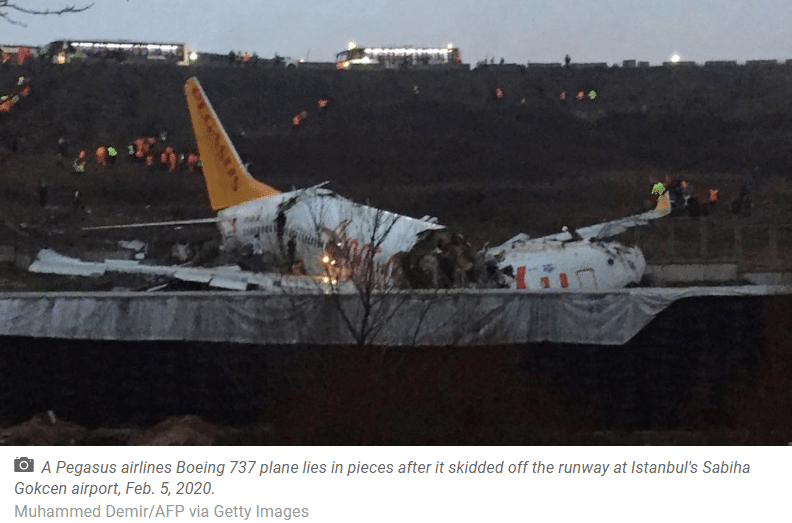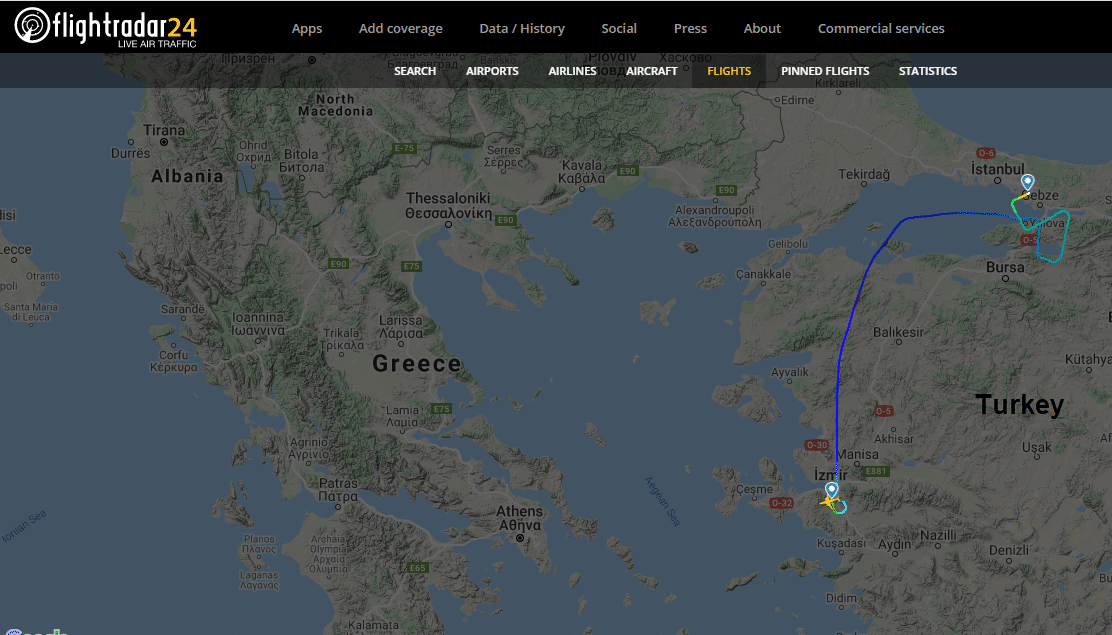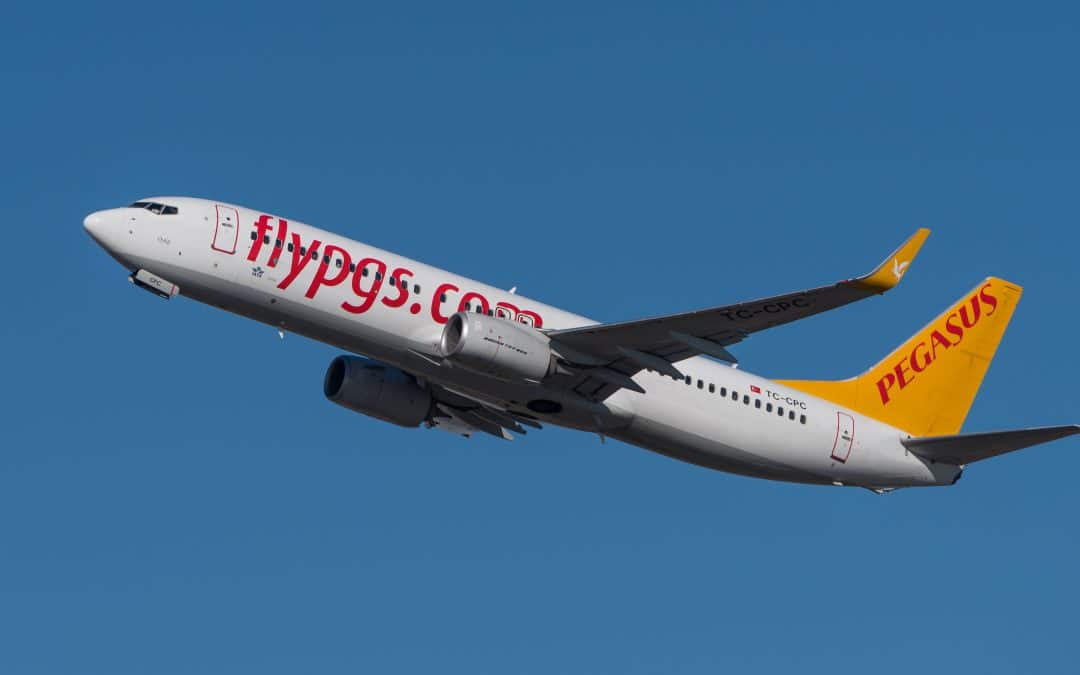First of all, I want to extend my condolences to the families that have lost loved ones on this flight. If you are a fearful flyer, this incident naturally causes concerns and brings up a lot of questions. It’s important however to separate facts from fiction, or, as we call it here at FearlessFlight®, the stories you might tell yourself that flying just isn’t safe and why your anxiety is indeed justified.
Here are the facts, or what we know at this early stage. Below that, I will address the questions that we have already received and that you may have.
On 5 February 2020, a Boeing 737-800 skidded off runway 06 while landing at Istanbul-Sabiha Gökçen International Airport, Turkey.
The 737 went past the end of the runway (3000x45 m in length), falling down a steep embankment (90-120 feet) before coming to a stop meters from a busy multi-lane highway.

The Boeing 737 was trying to land in heavy tailwinds and rain. The plane couldn't hold on the runway due to poor weather conditions and skidded for around 165-200 feet.
The fuselage broke into three parts and caught fire. Firefighters and ambulances were dispatched to the scene immediately after the accident.

Transportation Minister Cahit Turhan stated that the accident happened due to a “hard landing.”
Three people were killed, 179 people were injured, and the aircraft broke into three parts.
Turkish nationals made up the majority passengers, but local media quoted the airline’s records as saying there were 22 foreign passengers from 12 other countries.
The flight originated from Izmir Adnan Menderes International Airport (ADB).

Both the Turkish pilot and the South Korean First officers were injured in the crash. Istanbul’s public prosecutor has launched an inquiry.
TC-IZK was delivered in February 2009 and is currently at the age of 11. It belonged to Air Berlin until May 2016.
Pegasus, a budget carrier is the country’s second-biggest airline. The airline has been in operation for 20 years, has a fleet of 83 aircraft, including 47 Boeings and 36 Airbuses.
It is the first fatal accident in the airline’s history.
Earlier this year, an arriving Boeing 737 belonging to Pegasus skidded off the runway at Sabiha Gokcen in heavy rain, with passengers evacuated via emergency slides.
Your mind says to you, “There it is. I told you. Flying is not safe. Once again, Boeing is in the news. The 737 is in the news. And the -800 is in the news. What more evidence do you need?”
The trouble is, the part of your mind that’s talking to you is an operation of the brain that evolved hundreds of thousands of years ago and doesn’t rely on facts or verification. Your belief is formed and that’s that.
But the part of your brain that’s sending those messages is like a smoke detector which only detects smoke. It does not distinguish between whether the smoke is coming from toast burning or a grease fire—each requiring different levels of response. Our “smoke detector”—called the Amygdala—warns in the same way. It doesn’t discern between real and imagined threats. It just hijacks our attention to alert us to what may be a problem.
Here are some questions that have already come in from followers:
- Is the Boeing 737-800 safe to fly on?
The Boeing 737-800 (not the MAX version) has had some issues (cracked “pickle forks) that have surfaced. Whether any of those issues served as either primary or contributing causes in this accident is unknown at this time. - What’s going on with Boeing and their airplanes? Can I ever feel safe on one?
That’s the very question that Boeing, the FAA, and people around the world are asking. However, to link this accident to any cause at this time is premature. And to do so is to generalize which is neither fair nor sensible.As for feeling safe on a Boeing 800 or any Boeing airplane is dependent upon the story or stories that you tell yourself about this accident or any accident even after the findings are in.
- The articles I’ve read said that the airplane was landing in high winds and with a tailwind. And heavy rain. That seems risky and unsafe. How do I not worry about that?
There are well-defined limitations associated with airplanes certified as airliners and landing performance. That performance criteria includes landing in the touchdown zone (TDZ). The first 3,000 feet or the first half of the runway, whichever is shorter is the TDZ. Most of the airports that you will fly on commercial airlines are 6,000 feet or longer. Landing performance, i.e., the amount of runway to stop the airplane that is precomputed prior to each flight requires compliance to the rules. For obvious reasons, if an airplane lands beyond the TDZ, there is no guarantee of stopping in the required amount of runway. You can land in the rain and with a tailwind, but again there are limits that are built into the performance limits. Again, if you don’t meet those limits, all bets are off. Risk is part of everything in life from getting up out of bed (400-700 people die every year falling out of bed!) to driving to work. But we take measures to manage our risk. And the airline industry is the premiere manager of that risk, which is why commercial airlines are the safest way to travel on the planet. - Why do pilots try to land in these unsafe conditions?
No one has yet established anything of the sort. Pilots are human and make errors in judgement. Those type of “human factor-caused” accidents account for about two-thirds of all accidents. But you must once again remember that flying on a commercial airline is the safest way to travel. And as a causal factor, human factor-caused accidents are just as high in other forms of transportation. But because of the rarity of airplane crashes, they are much more likely to be reported and receive extensive coverage in the news. - This was a Turkish airline and they had another crash like this recently. I am flying to Turkey this spring. How do I know that I’ll be safe on other airlines and specifically, other European airlines?
You don’t. But you will do as we do and gather information from relevant sources to make an INFORMED decision before you choose which airline you’re going to fly. The standards for safety are world-wide. Stay connected to FearlessFlight® to help you make specific choices as to which airline to trust. - I am afraid that pilots don’t care about us passengers.
It might seem that way sometimes but after a 50-year career as a professional pilot, I have never had even one moment that I felt that way. And the fact that I am on the airplane with you would challenge common sense that I would make choices that would jeopardize your safety at the expense of my own. - I have seen scary crosswind landings. How do pilots know when they are too strong?
First of all, STOP IT! Watching scary crosswind landings, that is. J Seriously, you’re trying to re-program your thermostat that helps regulate your level of arousal (anxiety and worry). Watching something that is scary to you and that you likely don’t have a feel for the technical aspects of to start with can only add to the story you tell yourself about flying.As far as when we know when a crosswind is too strong, we get reports from the air traffic control tower as to the current velocity and direction of the wind. We use that to computer the actual crosswind component and compare it to the demonstrated limits for the specific airplane we are flying or the limits established by the operations manual for my particular airline—whichever is less.
While I understand your concern and your need for answers to your questions, it’s too soon to know exactly what happened. I hope that the answers above help to ease your concerns. But if you have others, be sure to check out special FearlessFlight® LIVE broadcast.




